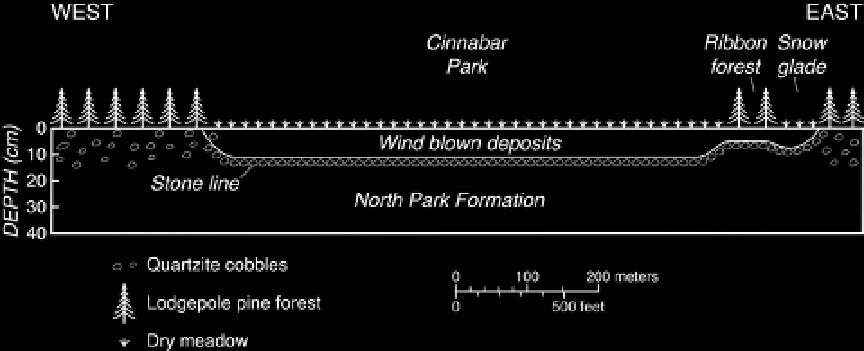Geoscience Reference
In-Depth Information
Fig. 13.4. Soil characteristics across cinnabar Park. the stone
line probably formed during a period when line soil particles
were eroded from the high plateau. new fine material gradually
accumulated to a depth of approximately 6 inches (15 cm), but
the establishment of tree seedlings in the dry meadow is still
difficult. See fig. 13.3. Adapted from Doering and Reider (1992).
tree seedlings are easily killed by a combination of frost
damage and reduced rates of photosynthesis the next
day. in contrast, summer freezing is rare under the for-
est canopy, if it occurs at all. two other factors limiting
tree seedling establishment could be excess competition
for tree seedlings with established herbaceous plants
and the kind of vertical discontinuity in soil texture
topography, and the chance establishment of a small
tree or shrub—which initiates snow deposition on its
leeward side—one or more bands or ribbons of trees are
sometimes found in the vicinity of snowglades.
the ribbon forest-snowglade pattern takes at least
band of trees and one band of meadow on the lee side
of a more extensive meadow, such as at cinnabar Park
where the late-spring snowdrift may be 30 feet deep or
more (see fig. 13.3). the initial origin of such meadows
is not easily explained. Dwight Billings, Duke Univer-
sity ecologist, suggested in 1969 that “forest fire near
timberline . . . changes the snowdrift pattern enough
that trees in an unburned area to the lee of the burn
are killed by late-lying snow during the summer. the
dead trees are replaced by a wet type of snowglade
observation that huge snowdrifts form on the lee side of
some clearcuts, usually 10-20 feet into the uncut forest,
and the effect of the drift is to reduce tree vigor. Dead
standing trees can be found even though the upwind
clearcut is less than 20 years old. over a period of 500
years or more, all remnants of the original forest could
disappear.
in other situations, usually near upper treeline, sev-
eral bands of forest and meadow may occur in sequence
is obvious, because the bands are perpendicular to the
prevailing westerly winds and the deepest snow occurs
Snowglades and Ribbon Forests
Meadows created by late-lying snow are known as
snow-
glades.
the soil is covered, cold, and wet for too long and
the growing season is usually too short for tree seed-
sists until midsummer favors the growth of molds that
can kill buried branches and young trees, for example,
the blackfelt snowmold (
Herpotrichia nigra
) (fig. 13.5).
in addition, pocket gophers that feed on tree roots and
bark are sometimes common under the snow.
tree seedlings, however, also have difficulty becom-
ing established where snow accumulation is low, in part
because of insufficient moisture. As important may be
insufficient protection from abrasion by blowing ice
and snow. Working in the Medicine Bow Mountains,
Stephan Hättenschwiler and William Smith found that
tree seedlings were favored in places where snow depth
was at least 18 inches but no more than 56 inches (fig.

Search WWH ::

Custom Search